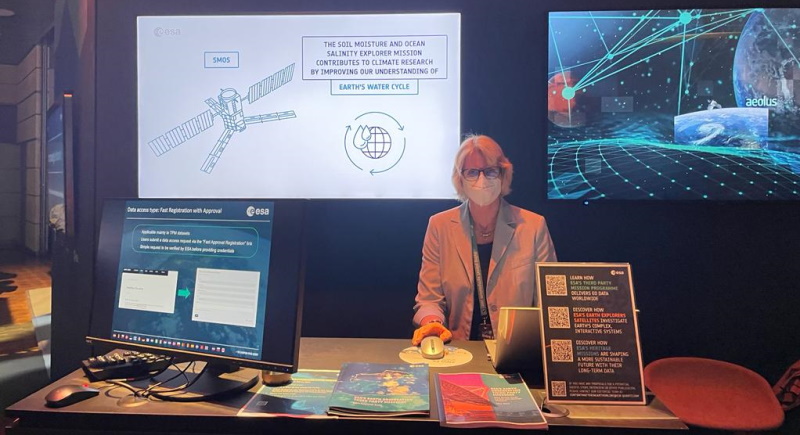- News & Events
- Highlights from Living Planet ...
Highlights from Living Planet Symposium
13 Jun 2022

As remote sensing scientists and data-users from around the world converged at the Living Planet Symposium (LPS) in Bonn recently, a common thread was evident in many scientific sessions and meetings – the right environmental data can accelerate our understanding of the rapid changes in Earth’s system.
There were a large cohort of data-users present, eager for updates about new Earth observation (EO) data products, mapping everything from methane emissions to land-cover, and to hear what is around the corner with soon-to-launch missions, such as EarthCARE.
The symposium revolved around the New York exhibition hall, hosting scores of institutional and industry booths. ESA’s Data Discovery and Access booth drew a wealth of visitors, where data-users learnt how to access data free-of-charge for ESA’s Earth Explorers, Third Party Missions (TPMs), and Heritage Missions.
On display was the newly published Third Party Missions Data Access Guide, showing not only how to access data, but also featuring detailed collection descriptions on over 50 TPM missions.
Climate modellers eager for EarthCARE data

Earth’s surface temperature is driven by the radiation balance at the top of the atmosphere, but this balance is being disturbed by greenhouse gases trapping heat in the atmosphere. One of the greatest uncertainties in Earth’s radiative budget is how clouds, aerosols and radiation interact.
EarthCARE aims to bridge this gap and so climate modellers eagerly await the mission’s forthcoming data products.
Björn Frommknecht, EarthCARE’s Mission Manager, says, “EarthCARE will not only ensure continuity in long term data series of global high-quality cloud-aerosol profiles collocated with radiation observations, but will also allow improvements in weather and climate models, as well as global and regional climate projections.”

EarthCARE is the largest of ESA’s family of research missions, the Earth Explorers. Multiple presentations at LPS covered the mission’s project implementation status and science activities, as it prepares for launch. The new mission logo was also revealed.
Colocation will be achieved using four instruments – a lidar, radar, imager and radiometer will all observe the same point on Earth at the same time.
Dirk Bernaerts, EarthCARE’s Project Manager, explained how the mission has quite a complex data processing model. Level-1 and Level-2 data products for all four instruments will combine into synergistic radiative transfer products (fluxes, radiances, heating rates) from 1D and 3D models.
Mammoth task of creating long-time series of data
Behind the plenary hall, attendees to sessions on heritage data in the Rhinelobby were treated to glistening views of the fast-flowing Rhine River and its passing barges.
Remote sensing data can track changes on different parameters of Earth’s system, but to see climate-relevant changes, multi-decadal time series of data are required. An example of this is the Advanced Very High Resolution Radiometer (AVHRR) sensor.
A variety of AVHRR sensors have been used on 13 different platforms during the last four decades, providing a wealth of long-time information. The mammoth task of creating the longest and largest AVHRR data series over Europe was undertaken by the University of Bern, through a dedicated project funded by ESA in the frame of the Heritage Space Programme.
Consolidating archived datasets from ESA, University of Bern and University of Dundee, some still stored on old media and in different formats, was a laborious process. The project team started by taking inventory, identifying gaps and filling them by using data from different sources. This process required the development of ad-hoc software to reformat the different flavours of archived AVHRR data to create a master dataset.
The data were then fully processed with a state-of-the-art processor, to implement the latest requirements expressed by end user communities, and then transferred to ESA for quality control and long-term archiving.
Data show early start of season
Finally, the AVHRR data for the whole 40-year period were made available on ESA’s Dissemination Service, where, as part of ESA’s Heritage Space Programme, they are accessible free-of-charge for users.
The impact of such long-time datasets on climate-related research was apparent at the symposium. Several Climate Change Initiative (CCI) projects have requested access to the full AVHRR dataset for their activities. A team from the German Aerospace Centre, DLR, shared their work to generate a timeline Normalised Difference Vegetation Index (NDVI) product, using a 40-year-old AVHRR dataset archived at DLR.
Mirko Albani, Heritage Space Programme Manager, says, “Long-time series of data acquired from space-born sensors are of utmost importance to support climate monitoring research activities. ESA will continue to pursue recovery and reprocessing of heritage data to extend time series and complement data from current and future missions.”
ESA’s evolving Third Party Mission Programme
As we advance efforts to reduce the impacts of the climate crisis, accessing the best bio-geophysical information about our planet is paramount. Commercial and national missions, which enable free access to their data through ESA’s Third Party Mission Programme, are fuelling the drive towards carbon neutrality.
Announced as a new ESA TPM at the symposium, Canadian GHGSat has a constellation of satellites enabling high resolution mapping of methane from space and providing actionable emission data.
Pléiades Neo, another new mission in the TPM programme, was also showcased at the symposium. Offering very high resolution 30 cm imagery, the four satellite constellation follows on from the still operational Pléiades mission.
At the symposium, scientists also showed how the short wave infrared (SWIR) images from the WorldView-3 satellite have been used for mapping of methane plumes globally at a spatial resolution of up to 3.7 m.
The significance of Earth observation data for decision making regarding the ongoing climate crisis was evident in many of the 240 science sessions and over 1300 oral presentations. With more than 5000 participants, this year’s LPS also broke records, underlining the acceleration of interest in environmental data across many application domains.